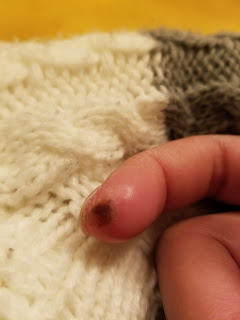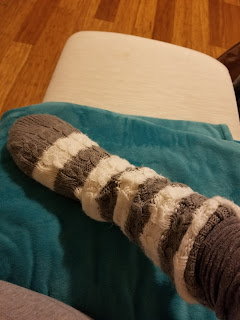Tiny but Mighty: What I Learned Fighting a Finger Ulcer

I pleaded with my doctor. “I want to chop off my finger! Please help me!” With pity in his eyes, he said, “It’s an ulcer. It’s common for people suffering from Raynaud’s syndrome.”
Looking down at my throbbing pointer finger, I asked why it was black. That was the moment I learned what necrotic meant. My finger was dying from a lack of blood flow. Similar to frostbite, the pain was unbearable, even though the ulcer was only the size of an M&M.

Lisa’s first painful finger ulcer emerged in 2018. (Courtesy of Lisa Weber)
This ulcer, my very first one, started in 2018 — four years after my diagnosis. I simply woke up one day to a painful white dot at the tip, just below the nail. Day after day, it got deeper and wider. It changed from white to pus-filled yellow, and ultimately morphed into black. Like someone had torched my skin until it was charred.
It was disgusting to look at, but that was not as much of a bother as the pain. It was very painful. The slightest touch felt like someone was smashing it with a hammer. I couldn’t sleep or focus. Heat helped just a tiny bit, so I wore a loose, fluffy sock over it that stretched all the way up to my elbow. As ridiculous as I looked, I couldn’t bear to wear a glove. The fabric sliding across my dying skin was torture. And without the extra layer of warmth, the throbbing pain and stinging lightning bolts were constant.
I was desperate for relief, so I sought out support groups, conducted research, and spoke to multiple doctors, and learned some tips for caring for a finger ulcer, and what can be done about one.
Keep it warm
Find something comfortable to wear that will keep it warm. Raynaud’s constricts the blood vessels, making it difficult for blood to reach our digits and toes. The heat helps dilate, or open up, those blood vessels so oxygenated blood can nourish the injured area.

Lisa wears a sock on her hand to try to ease the pain of an ulcer that appeared on her pointer finger. (Courtesy of Lisa Weber)
Keep it protected
Since we use our hands to do so much, banging the ulcer against something is inevitable. I found that loose-fitting finger splints add a layer of protection that diminishes the intensity of those blows and limits how many times I fall to the floor screaming in pain.
Keep it clean
If the finger ulcer gets infected, that definitely warrants talking to a doctor. Yellow pus or black areas are a sign of infection. Without adequate blood flow, our body needs help to clean out the area. I use high-quality bentonite clay, which consists largely of montmorillonite. I make a paste using water, cover the area, bite down on a towel to absorb my horrendous screams, and suffer until the clay fully hardens. As the clay dries, it draws out the infection. Afterward, I run my finger under warm water until it washes off. Doing this every day bought me time — it kept the infection under control and prevented my finger from being amputated.
Medications help
There are many creams and pills that can help restore the blood flow to the affected appendage. These are controlled substances, so they must be prescribed. My doctor prescribed Revatio (sildenafil), which I now take regularly. It helps keep my digits pink and healthy.
Surgery
When all else fails, surgery will be needed to keep the dead tissue from consuming more flesh. It’s also necessary to make sure the infection doesn’t spread to the blood or bone. I found an amazing hand surgeon who performed a digital sympathectomy. To put it simply, he cut open my hand and cleaned out the arteries responsible for cutting off the blood flow to my finger. After this procedure, the ulcer began to immediately heal, and my finger was saved.
Ulcers are not for the weak. Battling one takes a warrior’s strength. The incision from my surgery was 3 inches long and the entire width of my hand. Yet, the wound felt like a paper cut compared to my pea-sized ulcer.
To avoid the torture of a finger ulcer, be proactive. Avoid stress, stay warm, and act fast if a sore begins. Wearing winter gloves at a fancy restaurant is far less embarrassing now.
I’ve been fortunate to only have had a few tiny ulcers form since that first one in 2018. By acting quickly and diligently, none of them progressed into much more than an uncomfortable white dot that looked and felt like an indented pimple. I have a new ulcer forming right now, and I’ll be crossing my toes that the treatments I listed can once again keep it from becoming the monster I know it can be.
***
Note: Scleroderma News is strictly a news and information website about the disease. It does not provide medical advice, diagnosis, or treatment. This content is not intended to be a substitute for professional medical advice, diagnosis, or treatment. Always seek the advice of your physician or other qualified health provider with any questions you may have regarding a medical condition. Never disregard professional medical advice or delay in seeking it because of something you have read on this website. The opinions expressed in this column are not those of Scleroderma News or its parent company, Bionews, and are intended to spark discussion about issues pertaining to scleroderma.








Susan Davis
I have had scleroderma for the past 26 years. Recently, I had an ulcer on my tip of my middle finger. It was very cold and circulation was not getting to the finger. It eventually turned necrotic and painful.
My Rheumatologist gave me Nitobid ointment that they used for angina (chest pains). I applied a small amount to the back of the hand and to the fingers and it disappeared, taking the pain with it. I did not place the ointment directly on the ulcer.
I hope this may help!
Sue Parnell
I have had scleroderma and Raynaud's for 40 + years. I have an ulcer on my finger now that is big and deep. Nitrobid is not working for me. Lidocaine dies lessen the pain some what however. I have had it for 4 months now with no end in sight. They are horrible.
Phyllis Keatinag
I was diagnosed in 1 996 with crest disease. I've done ok over the years with taking the heart burn med and keeping my extremeties warm. l've had problems with shortness of breath over the years but in the last 6 months was in need of testing, lung and heart. Last week I was diagnosed with severe pulmonary hypertension and am one the books to see a pulmonary doctor in a couple of weeks. Anyone out there experiencing this? My original diagnosis was limited scleroderma but I don't know for sure if that is the case now.
Douglas Garcia
My dermatologist used Botox injections to control the Raynaud's. The digital ulcers healed. The procedure has to be repeated every 3 months or so, but it does seem to work. I'd rather put up with the pain from the injections than lose a couple of fingers.
Michelle Enyeart
Your pain is so very real to me. I too have dropped to the floor in agony. My occupational therapist made a finger cover protector for protection of the site. Ive learned at the early stages a warm salt soak in a bowl does wonders for pain and healing. We are WARRIORS.
JO KEISER
YOUR SCLERODERMA MAY HAVE BECOME SYSTEMIC...CERTAINLY SOUNDS LIKE IT. YOUR RHEUMATOLOGIST WILL HAVE TO MAKE THAT DIAGNOSIS. I'VE LIVED WITH PULMONARY FIBROSIS AND PULMONARY HYPERTENSION FOR SEVERAL YEARS. IT CAN USUALLY BE PRETTY WELL CONTROLLED WITH MEDICATION, SO I'M GLAD YOU'RE GOING TO THE DOCTOR. HOPEFULLY HE OR SHE CAN EASE YOUR MIND.
Ann Luttrell
Hi Lisa. I have had CREST (and still have it! I was diagnosed in 2000) I have had regular infusion of Iloprost for the last 10 years. I thought I had got off lightly until one of my fingers was very painful with nothing to see that would cause pain. I ignored it and thought it was yet another annoyance of scleroderma. Then just under the base of my nail there was a very small area that looked like bruising. I ignored it. Eventually however it became very, very painful so I went to see the wound nurse at my local health centre. It was infected by now so I was given some antibiotics and the nurse treated the finger and put a dressing on it. To cut a long story short after 3 lots of antibiotics and even more pain - I couldn’t ignore it now 😥😥 I ended up showing my finger to the Consultant at a routine hospital appointment. The nail appeared to be dying (which it was) and the pain was incredible. Lots of things happened until eventually I had the end of the finger amputated along with removal of nerves in my palm. I don’t think there is an adjective that adequately describes the level of pain that I had at this stage. I have given birth to 2 children, had major operations and other painful procedures but nothing was comparable to this pain. I was given very strong pain killers (including morphine and codeine) which dampened the excruciating pain but never really got rid of it. I am learning to live without the end of the finger missing but I do keep dropping things!! Anyhow the learning from this
experience has resulted my checking my hands everyday and I will go to the doctor/nurse as soon as I find anything untoward. I will not ignore any pain because I really do not want to go through this again. EVER😭😭😭